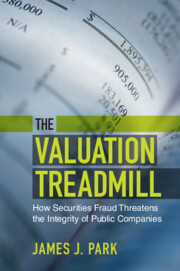Book contents
- The Valuation Treadmill
- The Valuation Treadmill
- Copyright page
- Dedication
- Contents
- Acknowledgments
- 1 Introduction
- 2 Xerox and the Pressure to Meet Projections
- 3 Penn Central and the Decline of Managerialism
- 4 Apple and the Controversy of Projections Litigation
- 5 Enron and Sarbanes–Oxley
- 6 Citigroup and the Financial Crisis of 2008
- 7 General Electric and the Problem of Earnings Management
- 8 The Future of Securities Fraud Regulation
- 9 Conclusion
- Notes
- Index
8 - The Future of Securities Fraud Regulation
Published online by Cambridge University Press: 14 July 2022
- The Valuation Treadmill
- The Valuation Treadmill
- Copyright page
- Dedication
- Contents
- Acknowledgments
- 1 Introduction
- 2 Xerox and the Pressure to Meet Projections
- 3 Penn Central and the Decline of Managerialism
- 4 Apple and the Controversy of Projections Litigation
- 5 Enron and Sarbanes–Oxley
- 6 Citigroup and the Financial Crisis of 2008
- 7 General Electric and the Problem of Earnings Management
- 8 The Future of Securities Fraud Regulation
- 9 Conclusion
- Notes
- Index
Summary
The thesis of this book is that securities fraud became a threat to the integrity of public companies as markets increasingly valued them based on projections of their future earnings. It became important for companies to consistently validate prior forecasts of their profitability to maintain their stock price. This created a systemic incentive for corporate managers to manipulate market perceptions of their company’s earnings potential. The Sarbanes–Oxley Act of 2002 (Sarbanes–Oxley) was an attempt to address this incentive by requiring all public companies to invest in measures that prevent financial misstatements. The law governing Rule 10b-5 developed as private investors and the SEC increasingly scrutinized whether misleading corporate narratives of the future were motivated by fraudulent intent.
Keywords
- Type
- Chapter
- Information
- The Valuation TreadmillHow Securities Fraud Threatens the Integrity of Public Companies, pp. 129 - 146Publisher: Cambridge University PressPrint publication year: 2022

